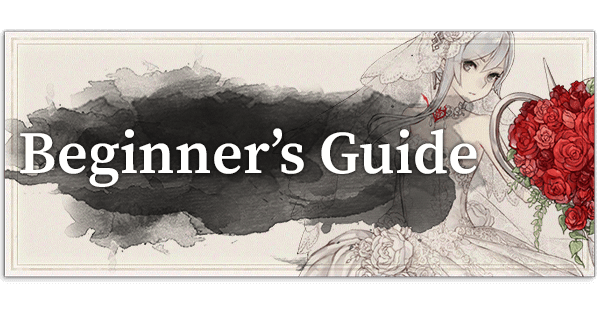Introduction
SINoALICE has an ample amount of concepts and mechanics that may be especially overwhelming for newbies, thus it’s important to at least know what a new player needs to do upon their first playthrough in order to progress accordingly. Summarizing stuff from all the other guides, here are stuffs SINoALICE beginners need to take note before starting the game.
What to Aim For During Reroll
As everyone may know, the first thing the game leads players to is an immediate gacha screen and every player will be given a 10-roll to start out. This makes rerolling especially easy to do, and a thorough guide on how to reroll can be found here.
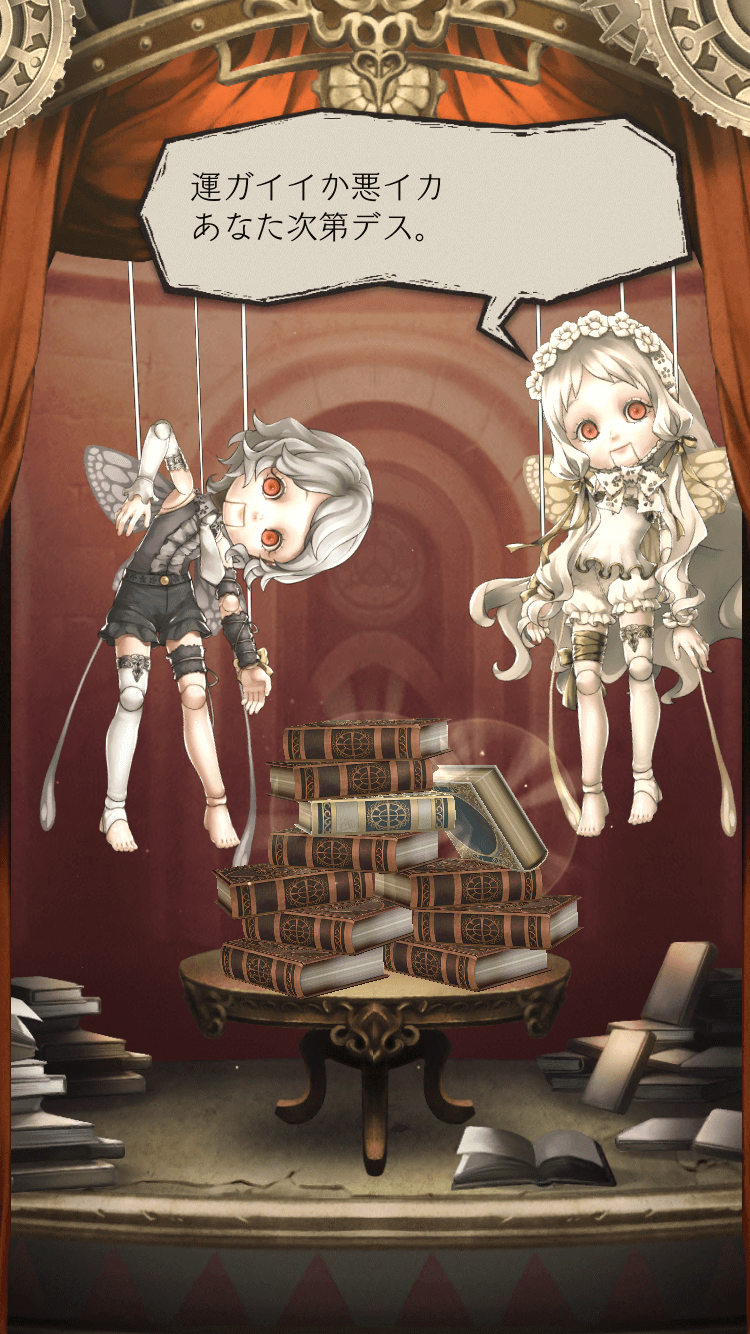
As the gacha pool isn’t that big on release, any SS/SR would be a fine outcome, but try to aim for a SS/SR weapon that unlocks a job. The ideal amount of SS/SR here would be 2 to 3 at minimal, and even better if they all come with a job. There is NO tier list on jobs, so any job will generally do.
Additionally, the fundamental purpose of rerolling for jobs in this game is to get as many stats as possible. There are several S weapons that also come with a job, but they give less stats than those from SS/SR weapons. Their weapons won’t be really usable after awhile, and with how S jobs are easier to pull than SS/SR job, players will eventually get them even outside of rerolling so prioritize jobs from SS/SR weapons nonetheless.
Basic Gameplay

Gameplay requires the player to control a character with a specific job, equipped with a maximum of 20 weapons, 4 armor pieces, and 5 nightmares on them. Note that unlike in other gacha games, only one character can be controlled, and the rest of the participants are either CPU-controlled or players joining the session through co-op. This is why it is strongly encouraged to build a proper weapons grid, as a character is merely seen as a vessel using them while the weapons are the ones carrying the skills.
Weapons
There are a total of eight types of weapons in the game classified under two groups: Fighter/DPS and Support.
・Fighter/DPS Grid consists of:
- Sword: Single-target physical Damage.
- Hammer: Multi-target physical Damage.
- Bow and Gun: Single-target magical Damage.
- Polearm: Multi-target magical Damage.
・Support Grid consists of:
- Staff: Heals allies.
- Instrument: Buffs allies.
- Tome: Debuffs enemies.
- Orb: Multi-target magical Damage.
There’s also 3 elements present in this game, with the weakness chain being the classic Rock-Paper-Scissors:
-
Fire is strong against Wind but is weak against Water.
-
Water is strong against Fire but is weak against Wind.
-
Wind is strong against Water but is weak against Fire.
Not restricted to limit-breaking, this game also allows weapons to evolve into a higher rarity: A to S, S to SS/SR, and SS/SR to L. Note that evolved SS/SR weapons with A or S initial base will still be inferior to weapons with SS/SR as base, as they have lower cost and skill tiers. The materials required for both evolution and leveling can easily be farmed in daily quests open during certain times:
| Squirming Darkness - Weapon Lv Mats |
Schedules(JST) |
|---|---|
 |
01:00 07:30 12:00 19:30 22:30 |
| Squirming Darkness - Armor Lv Mats | Schedules(JST) |
 |
01:00 07:30 12:00 19:30 22:30 |
A weapon has 3 types of skills:
-
Story Skill
-
Colosseum Skill
-
Colosseum Aid Skill
Story Skills, as their name suggest, only work in story mode battles. Meanwhile, Colosseum Skills work in Colosseum and Colosseum Aid Skills are passives that have a chance to proc during Colosseum.
For beginners, it is advised to focus on levelling weapons first and foremost than on raising skill levels. Skill level becomes much more prominent and important later, but it’s not really a priority due to how the materials needed to level up skills are harder to obtain than weapon level mats, especially for new players. Thus, it is advised to focus on raising stats first to get through story mode and collect Twilight Crystals to roll for better weapons.
Jobs
A job is a specific version of one of the SINoALICE characters representing a class. These are the character units that are used in battles, and is where weapons and nightmares are equipped. Similar to weapon categories, jobs are also classified under two types: Fighter/DPS and Support. Fighter/DPS jobs cannot equip the weapons classified under support grid, and vice versa. Note that a job also gives bonuses when used in its character’s story stages.
Each job has its own specialization over a certain weapon:
| Job Name |
Specialized Weapon |
|---|---|
| Breaker |
Sword |
| Crusher | Hammer |
| Gunner | Bow & Gun |
| Paladin | Polearm |
| Cleric | Staff |
| Minstrel | Instrument |
| Sorcerer | Tome |
| Mage | Orb |
Jobs are levelled up by using proficiency, which is obtained through spending SP on battles.
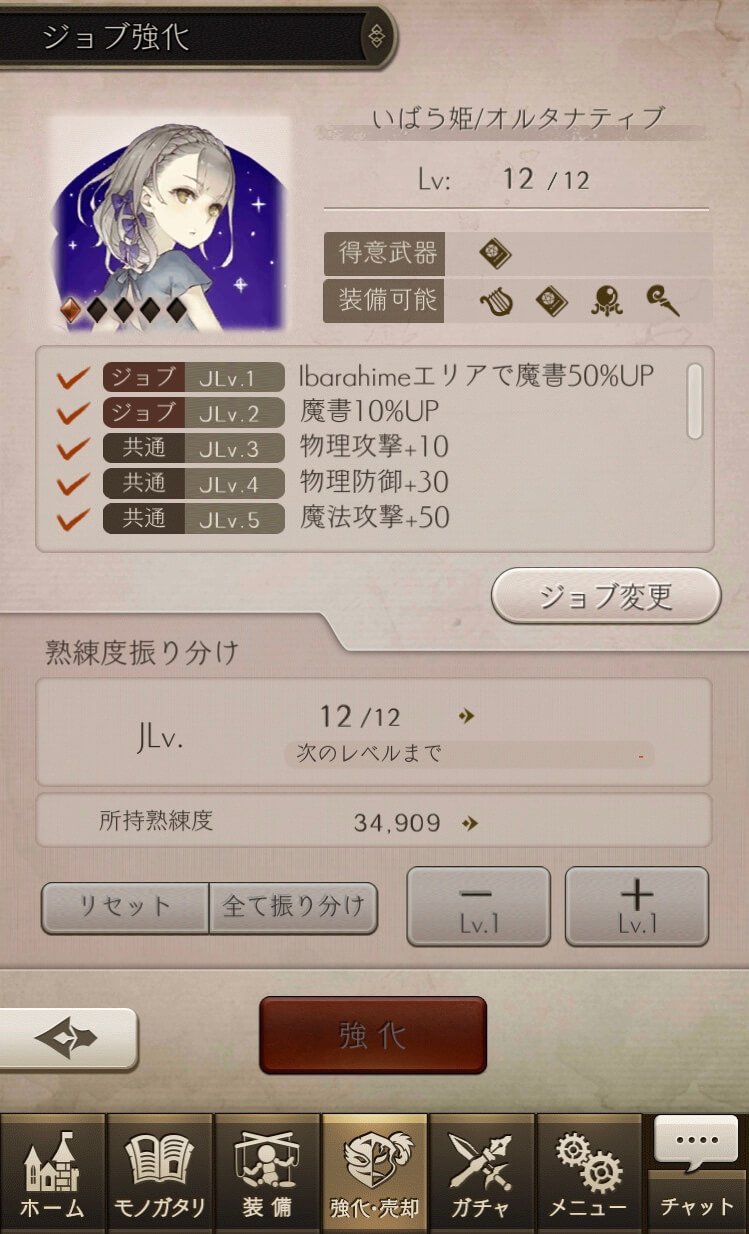
As mentioned before, jobs have no tier list. When not taking character areas into account, every character will have the same bonuses upon usage for the same job type, so it doesn’t matter who you pick at first. There are, however, several job types categorized as below:
-
Standard: The usual, normal type of jobs. Additionally, some others such as Xmas, Valentine, and many more Limited jobs might share character/job combination as the Standard line-up but are considered as a separate unit and present different models.
-
Alternative: Similar to Standard jobs, but they give many stats in comparison when levelled up. As for bonuses, they’re pretty much the same as Standard jobs.
-
Half-Nightmare: these jobs give their specialized weapon a higher bonus that’s not area-dependant but reduces the effectiveness of two other weapons by 75% each. This is why half-nightmare jobs are not newbie-friendly, and are highly advised to be used only when there are enough weapons as to make a grid without demerits. Thus, the ideal Half-Nightmare grid would be 20 of its specialized weapon. These are particularly designed for fighting in the Colosseum. Half-Nightmare jobs are obtainable only through Grand Medals exchange.
Sin Series: Similar to Half-Nightmare jobs, except they give specific bonuses to both elemental and weapon type, and reduce another element by 75% instead of other weapon types, making them a little bit more flexible than Half-Nightmares but harder to take full advantage of. Additionally, unlike Half-Nightmare jobs, the Sin jobs are better suited for Story.
For more explanation on Jobs, check out the Jobs Explained guide here:
Armor
Armor is a type of equipment that provides defensive stats and special bonuses to weapon skill effectiveness and damage dealt to certain enemies. For this it is necessary to have all 4 pieces of the same armor set equipped. Note that armor sets can have different kinds of armor pieces each boosting a particular weapon type’s skills, so it is recommended to collect all 4 of a desired weapon type. Armor bonuses only work on Story Mode and not on Colosseum. At best, armor is only equipped for defensive stat purposes in Colosseum grids.
Nightmare
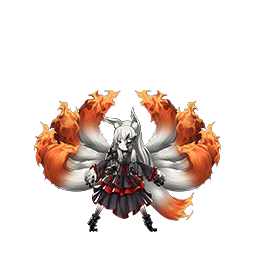
A Nightmare is a type of monster that can be equipped to a job just like weapons and summoned to aid allies and cripple opponents. On call, it provides various effects depending on the Nightmare used such as changes to either allies or enemies’ stats, increased effectiveness on weapons, SP or HP recovery, or some special mechanics like resisting fatal blows.
Keep in mind that a nightmare might have a DIFFERENT skillset for Story & Colosseum. For more information on Nightmares, their skills, and also how other parts of them differ from each other, check out our Nightmares Explained guide below!
Joining a Guild
SINoALICE emphasizes heavily on its guild-related activities, and joining one is highly recommended as, beside Colosseum, most events and their exclusive missions include co-op rewards with guild members. Most importantly, guild bonuses in both events and missions also give a lot of Twilight Crystals and mats which will ultimately quicken a beginner’s progress inside the game.
Additionally, Colosseum is arguably one of the most challenging features of the SINoALICE experience, and there’s nothing more satisfying than being able to achieve victories thanks to every guild member’s hard work besides the various rewards gained from them, so be sure to consider joining one!
Colosseum
Colosseum is a guild vs guild battle happening once a day during the guild’s picked schedule. It lasts for 20 minutes in a certain timeslot either the guild leader or vice picks for the guild, so it’s advised to pick guilds within a Colosseum timeslot that the player can regularly attend. Colosseum rewards include Nightmare EXP mats and Charm Medals that can be used to exchange for various items, weapons, and even some Nightmares!
In Colosseum, there are 5 players placed in the front: they’re called vanguards, who serve as the guild’s damage dealers and receivers, with the rest of the guild members in the backline/rearguard, so it is advised they go as supports since damage weapons such as Fighter/DPS weapons and Orbs are penalized for about 75% in rearguard. The 5 strongest guild members are automatically chosen to be the vanguard by the system unless a player’s Colosseum settings are set to rearguard, which is usually what a support should set.
The most important point in order to win a Colosseum match is to gain as much inochi(damages) as possible. The guild that has the most inochi when match ends will be declared the winner. To learn more about Colosseum and its system, refer to the guide here.
Strategies involved in Colosseum are very teamwork-focused as there are many aspects that need attention, such as how each player can only summon one Nightmare per fight. Reading the enemy’s moves and their line-up is also important for many cases, as well as determining what Nightmare is best to use at certain situations. Communication between guild members will be the key to win matches in general.
Note that main & sub sets CANNOT be changed at 30 minutes before Colosseum starts. This is something that many beginners need to be careful of, so make sure to prepare and pick what grid to use in Colosseum before the 30 minutes mark!
Setting Up the First Grid and Knowing What to Focus on
It’s important to know what to focus on as a newbie, especially for the grid. As we all know, unlike other games, SINoALICE doesn’t emphasize on its characters – the heart lies in the equipped weapons instead.
Out of all 8 available roles, it may be hard to decide which one to focus on. The easiest way to choose would be to main the role that can be best equipped. For newbies, this heavily lies in early gacha pulls from reroll and from some other banners afterwards.
It is, however, advised for newbies to build a DPS grid during early days to be able to carry through Story mode chapters for Twilight Crystals farming, since the main objective will be having as many Twilight Crystals as possible to pull gacha for better weapons. Story completion is also important for missions and to get some jobs unlocked. Additionally, gaining twilight crystals via other ways beside farming in story mode is also available to consider. However, if a working DPS grid is impossible, it is still possible to clear Story chapters as a Support. Focus on staves to heal allies and let them carry.
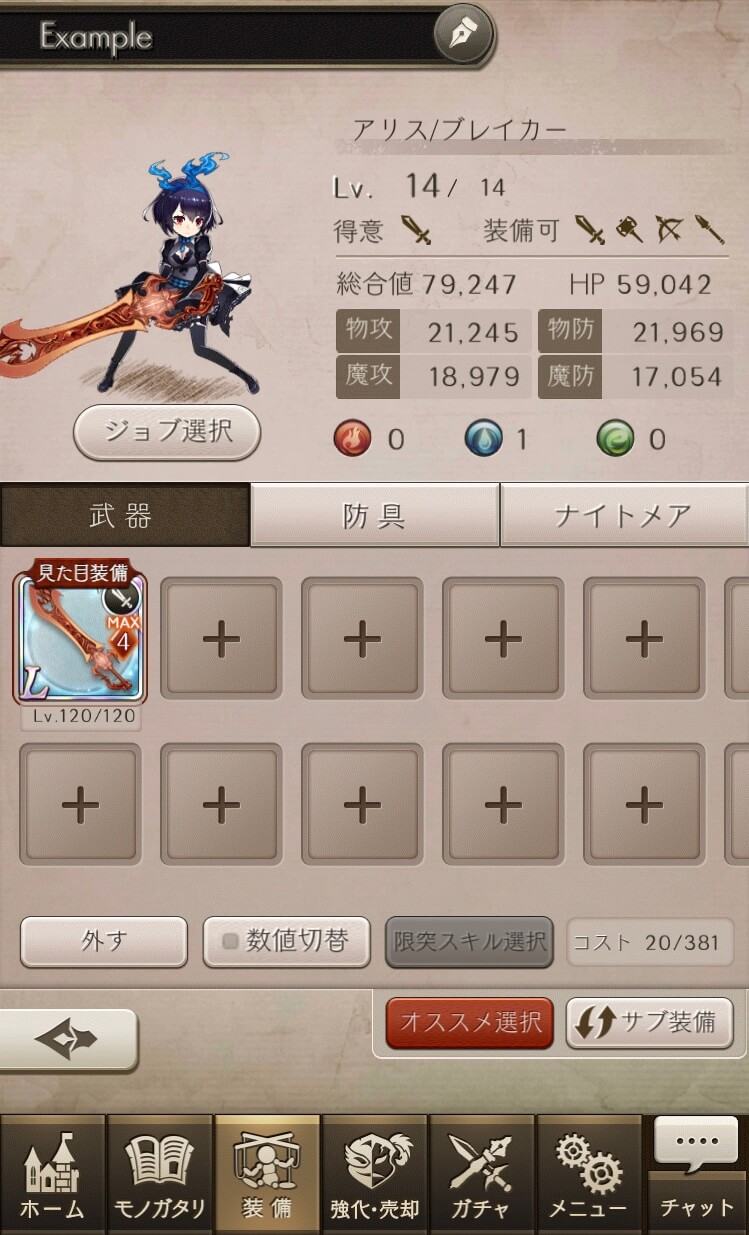
After a considerable amount of SS/SR weapons have been obtained, it is time to consider what role to main. Going with a DPS grid as a newbie is fairly more flexible than support due to how one only needs to collect and raise as many of the 4 available DPS weapons as they can. As the game evolves, however, DPS is expected to be able to flex especially in Colosseum and Raids and due to this DPS becomes one of the hardest roles to establish. This is, however, merely something a DPS main should work on upon reaching mid to endgame, but knowing this for newbies is essential nonetheless as a heads-up.
A support grid on the other hand will be a bit on the harder side to raise for newbies. For instance, it’s basically focusing on raising only one type of weapon: whether it’s staff for cleric, instrument for minstrel, tome for sorcerer, or orb for mage. Other additional weapons beside the role’s specialized weapon are generally raised for Colosseum shinma purpose by some players. It is however not really advised for support newbies to raise other weapons as it’s already hard enough to build a 20 SS/SRs+ grid of the same weapon in early days. However, a support grid will be eventually easier to build than a DPS grid due to how the latter is expected to flex the more they progress.
Story Mode

Story mode will be basically a newbie’s source of Twilight Crystals. It is heavily encouraged to frequently do Story mode as much as possible at the start since it’s the easiest and fastest way to obtain Twilight Crystals. To help this, players should take advantage of the unlimited purification tries low-rank players have and timing rank-up refills when out of stamina. Here are some tips in farming Story mode:
- Setting Up CPUs: as a newbie, several advanced stages may be hard to clear with no proper grid available. Fortunately, the game allows players to set their own CPU line-up instead of giving random weak CPUs! All that needs to be done is to just follow as many strong players as possible, then set them as your CPU companions afterwards. Note that this will set rooms as private, and no other players will be able to join.
- Using DPS Grid for Fast Clear: this is a given since most support roles beside mage can’t really deal much damage to enemies, hence also a reason why it is encouraged to have at least a DPS grid set upon starting out. No need to worry about what kind of weapons are in the grid or whatsoever as a newbie; just hit that optimize button to get the strongest weapons in and the grid is ready. If there’s an overabundance of a certain weapon type, make sure to select its matching job to take advantage of its bonus.
Raids
Raids are high-level content requiring certain set-up or strategies alongside high stats, but provide good compensation for very low AP usage and clear rewards that will be a huge help to newbies: an SS/SR Nightmare. This makes it worth to participate in raids once you’ve reached 50k+ total stats which is the power requirement to do most raid stages.
Note that there are however many gimmicks involved in raids, and checking out the notice in-game to see details regarding the current raid boss might help in your conquest. It is highly not recommended for newbies to auto throughout raids as it is hard content and once all players die, the game will not allow continues with Twilight Crystals like normal Story battles.
Events
In SINoALICE, there are several types of events, the most common being:
- Medal Event: where medals dropped in stages are obtained through missions in order to exchange them for Twilight Crystals, items, mats, limited rewards, and many more. These are the most recommended events to do for newbies, especially since there are rewards from both guild and individual bonuses. Collab events can fall into these.
- Armor Event: where players can grind for an exclusive armor set and materials throughout the event.
- S Job Event: provide a free job upon clearing the event and arcanas through either stage clear rewards and/or missions.
- Shooting Gacha Event: more or less the same as medal events with both individual and guild-wide milestones present. However, tickets are provided instead of medals and are used to pull from a special screen for items, mats, some limited stuffs, and many more. Some Collab events also feature this system.
Charm Medal Shop and What to Exchange for
A lot of weapons, Nightmares, and mats are also available to exchange at the Charm Medal shop. Charm medals are obtained as Colosseum participation rewards daily and when limit-breaking/selling S and up rarity weapons, so they are the easiest medals to obtain regularly in the game so far.

Weapons available in the Charm Medal shop are the easiest to max limit break as all needed copies are there; hence it is recommended to exchange Charm Medals for any weapon of a role planned to main. They will be a huge stats boost for a while until better weapons are obtained, and they will perform well skill-wise due to their skill level cap increasing to level 20 upon max limit break.
Nightmares available for exchange in the Charm Medal shop, on the other hand, aren’t a really good investment as they provide very little stats in comparison to most Nightmares in the game even at max limit break. They’ll basically leave the grid shortly after better nightmares are obtained especially since raids happen often; hence it’s better to exchange for something else like weapons or even other items like proficiency books and Nightmare level-up mats, as these are hard to come by at first.
Nightmare Dispatch
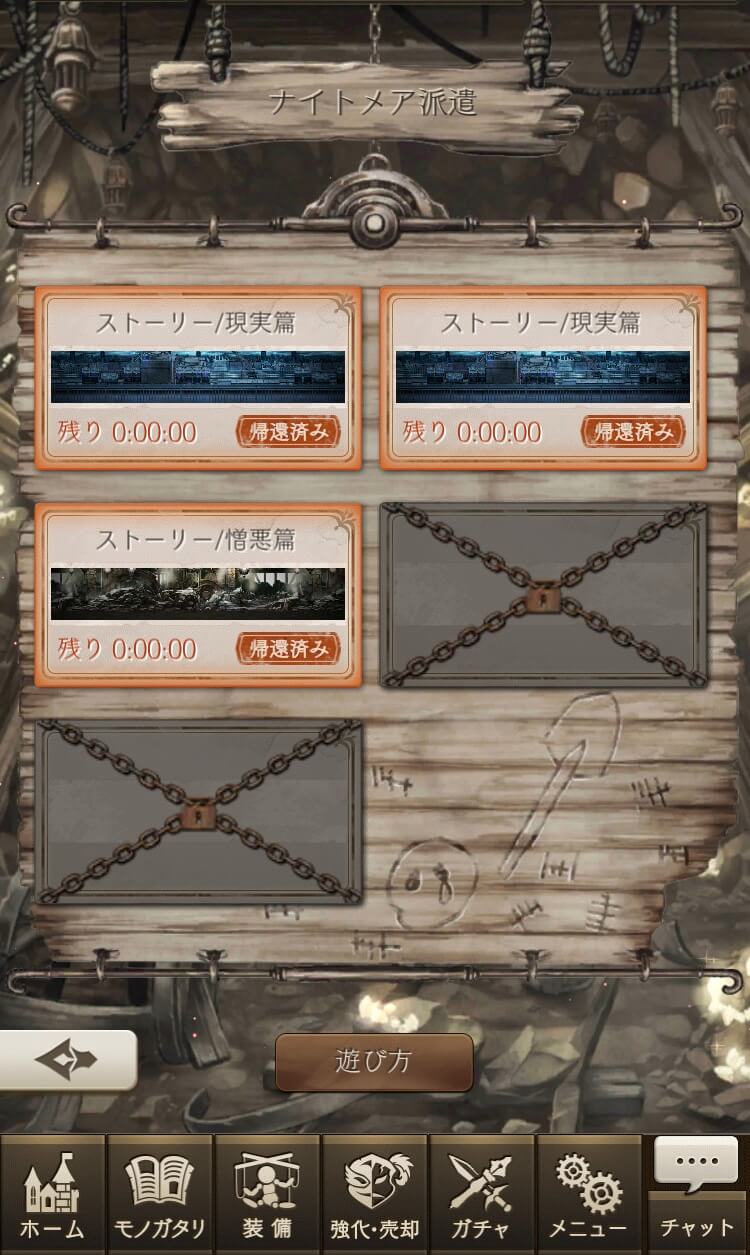
This is a feature that came to JP SINoALICE quite a while after release. It is a system where players can send off their Nightmares to expeditions for a few hours, and they’ll bring back some mats upon clearing. You can send up to a maximum of three expeditions at the same time with five nightmares on each group. There are two other slots but those are locked, costing 100 Twilight Crystals to unlock. Rewards commonly include armor evolution mats, nightmare evolution mats, and other miscellaneous stuffs such as Charm Medals, cleaning tickets, or even Twilight Crystals!

